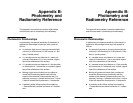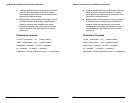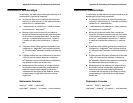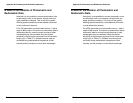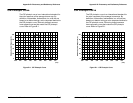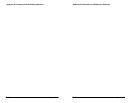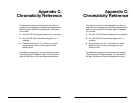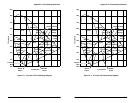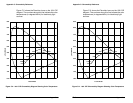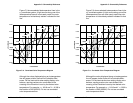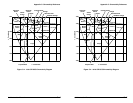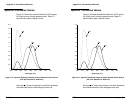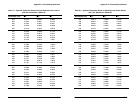
Appendix C: Chromaticity Reference
Appendices
C-2
The 1931 CIE Chromaticity Diagram
The 1931 CIE chromaticity diagram, also known as a
Kelly chart, is shown in FigureĂCĆ1. The diagram can be
used to categorize chromaticity measurements exĆ
pressed as x, y values. The x, y values are determined
from the spectral tristimulus values (X, Y, Z), by the
following equations:
x +
X
X ) Y ) Z
y +
Y
X ) Y ) Z
The main features of the 1931 CIE chromaticity diagram
include:
H All colors perceptible to the average human eye fall
within the bounded area of the chart.
H A straight line drawn through two colors, and
passing through the equal energy point (xĂ=Ă0.333,
yĂ=Ă0.333), indicates complimentary colors.
H Saturated colors, which are located on the periphĆ
ery of the bounded area, are monochromatic,
except on the purple to red boundary. Colors
become progressively less saturated toward the
white achromatic region in the center. The degree
of saturation is a measure of color purity.
H Boundaries between colors are not distinct; one
color blends gradually into the next.
H The ratio of distances between two colors to a third
color located on a line drawn between them is
proportional to the ratio of intensities of a mixture of
those two colors required to produce the third
color.
The principal disadvantage of the x,y chart is that equal
distances on the diagram do not represent equal
perceived color distances.
Appendix C: Chromaticity Reference
Appendices
C-2
The 1931 CIE Chromaticity Diagram
The 1931 CIE chromaticity diagram, also known as a
Kelly chart, is shown in FigureĂCĆ1. The diagram can be
used to categorize chromaticity measurements exĆ
pressed as x, y values. The x, y values are determined
from the spectral tristimulus values (X, Y, Z), by the
following equations:
x +
X
X ) Y ) Z
y +
Y
X ) Y ) Z
The main features of the 1931 CIE chromaticity diagram
include:
H All colors perceptible to the average human eye fall
within the bounded area of the chart.
H A straight line drawn through two colors, and
passing through the equal energy point (xĂ=Ă0.333,
yĂ=Ă0.333), indicates complimentary colors.
H Saturated colors, which are located on the periphĆ
ery of the bounded area, are monochromatic,
except on the purple to red boundary. Colors
become progressively less saturated toward the
white achromatic region in the center. The degree
of saturation is a measure of color purity.
H Boundaries between colors are not distinct; one
color blends gradually into the next.
H The ratio of distances between two colors to a third
color located on a line drawn between them is
proportional to the ratio of intensities of a mixture of
those two colors required to produce the third
color.
The principal disadvantage of the x,y chart is that equal
distances on the diagram do not represent equal
perceived color distances.




